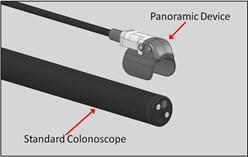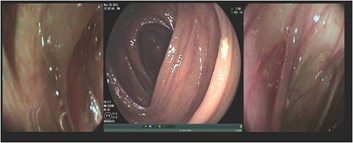SUNNYVALE, Calif., Oct. 21, 2014 (GLOBE NEWSWIRE) -- Avantis Medical Systems, Inc., a technology leader in developing novel digital imaging devices, today announced the results of a feasibility study demonstrating that use of the Third Eye® Panoramic™ device with a standard colonoscope was successful and provided enhanced, wide-angle imaging of the colon without adverse events. The results of the second phase of the study are being presented during the American College of Gastroenterology Annual Scientific Meeting (ACG 2014) taking place in Philadelphia.
Photos accompanying this release are available at
http://www.globenewswire.com/newsroom/prs/?pkgid=28530
http://www.globenewswire.com/newsroom/prs/?pkgid=28531
The study, "Expand the View but Keep Your Scope – Initial Results Using the Third Eye Panoramic Cap for Colonoscopy," is being presented in a poster session by Moshe Rubin, MD, Associate Professor of Clinical Medicine and Director of the Division of Gastroenterology at New York Hospital Queens, Weill Cornell Medical College.
The study involved 29 patients who were scheduled to undergo colonoscopy at New York Hospital Queens. For each patient, the Third Eye Panoramic device was attached to the colonoscope at the beginning of the procedure and provided additional views of the left and right sides to complement the forward view of the colonoscope.
While colonoscopy is well-recognized as the standard for colorectal cancer detection, there are limitations to the procedure. Research has shown that even when performed carefully by experienced physicians, standard colonoscopy misses about 22-24% of pre-cancerous polyps called adenomas1-3 and misses about 12% of large adenomas – measuring at least 1 cm – which are the ones most likely to transform into cancers.4-6
Although there are other reasons why they can be overlooked, two-thirds of the adenomas missed during colonoscopy are located behind the numerous folds in the colon, where they are hidden from the forward view of the colonoscope.4 Adenomas in "blind spots" behind these folds are easily missed, even with the most meticulous examination.
The Third Eye Panoramic device utilizes technology that was developed for the company's earlier product, the Third Eye® Retroscope®, which proved very effective in detecting additional adenomas behind folds. Like its predecessor, the Panoramic device is designed to help physicians see behind folds, but with improved ease-of-use and reduced expense.
"We listened carefully to endoscopists as they told us what they liked about the Retroscope device and what they would like to see improved," said Jack Higgins, MD, Chief Medical Officer for Avantis Medical Systems. "Feedback based on thousands of procedures with that previous device showed that doctors want to see more of the colon by using an additional camera, but they need the product to be easy to use and inexpensive. Not surprisingly, doctors also told us a new device should allow them to continue using their preferred colonoscope."
"We leveraged our expertise to create a solution that addressed all of their feedback," said Dr. Higgins. The new Third Eye Panoramic device clips onto the outside of a colonoscope at its tip, leaving the instrument channel completely free for suctioning debris and for passing instruments. Also, the new device can be used with any standard adult or pediatric-size colonoscope."
While the earlier Retroscope device utilized a single additional camera that was aimed backward, the Panoramic device instead has two video cameras that are directed laterally from its left and right sides. Those video images are displayed on both sides of the colonoscope's forward view, and their combined images on a single monitor result in a panoramic view that reveals areas behind folds and flexures (sharp turns) in the colon during both intubation and withdrawal.
"We found that the side views from the Panoramic device were helpful for seeing areas behind folds," said Dr. Rubin. "The device didn't interfere with our ability to insert the colonoscope, and we were able to reach the cecum in every case. We also discovered that the device did not result in restriction of colonoscope mobility, tip deflection or retroflexion, and since the device did not occupy the instrument channel, there was no effect on suction and no interference with passage of snares and forceps through the channel."
The Third Eye Panoramic device is currently under 510(k) review by the Food and Drug Administration (FDA), and is not available for sale within the United States. Avantis demonstrated the device in its booth at ACG, but is not taking orders at this time.
About Colorectal Cancer
Colorectal cancer is the second-leading cause of cancer-related deaths in the United States. According to the American Cancer Society, about 150,000 people in the U.S. are diagnosed with colorectal cancer each year and almost 50,000 die from it. Screening and surveillance colonoscopies allow colorectal cancers to be found earlier, when the disease is easier to cure, and cancers can be prevented if adenomas are removed before they become malignant.
About Avantis Medical Systems and the Third Eye Panoramic Device
Avantis Medical Systems is focused on delivering cost-effective solutions for improved detection and prevention of cancers of the gastrointestinal tract. The company has an extensive portfolio of patents covering innovative devices based on the convergent technologies of micro-chips and enhanced video processing systems.
Avantis' earlier product, the Third Eye Retroscope, was inserted through the instrument channel of a standard colonoscope to provide the physician with a retrograde (backward) view of the lining of the colon. This retrograde view revealed lesions that were hidden behind folds where they couldn't be seen with the colonoscope's forward view alone. The Retroscope was shown in clinical studies to help physicians find over 23% more pre-cancerous adenomas than a standard colonoscope alone.
Avantis' new product, the Third Eye Panoramic device, utilizes much of the ground-breaking technology that was developed for the Third Eye Retroscope. The Third Eye Panoramic device features two video cameras that are directed laterally. Combining their images with the one from the colonoscope's forward-viewing camera creates an ultra-wide-angle panoramic view.
The Third Eye Panoramic device is currently under 510(k) review by the Food and Drug Administration (FDA), and is not available for sale within the United States.
1Rex DK, Cutler CS, Lemmel GT, et al. Colonoscopic miss rates of adenomas determined by back-to-back colonoscopies. Gastroenterology 1997;112:24-8.
2Van Rijn JC, Reitsma JB, Dekker E, et al. Polyp Miss Rate Determined by Tandem Colonoscopy: A Systemic Review. Am J Gastroenterol 2006;101:343-50.
3Heresbach D, Barrioz T, Ponchon T, et al. Miss rate for colorectal neoplastic polyps: a prospective multicenter study of back-to-back video colonoscopies. Endoscopy 2008;40:284-90.
4Pickhardt PJ, Nugent PA, Mysliwiec PA, et al. Location of adenomas missed by optical colonoscopy. Annals of Internal Medicine 2004;141:352-60.
5Hewett DG, Rex DK. Miss rate of right-sided colon examination during colonoscopy defined by retroflexion: an observational study. Gastrointest Endosc 2011;74:246-52.
6Siersema PD, Rastogi A, DeMarco DC, et al. Retrograde-viewing device improves adenoma detection rate in colonoscopies for surveillance and diagnostic workup. World J Gastroenterol 2012;18:3400-8.

